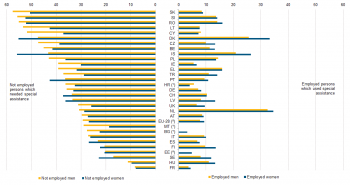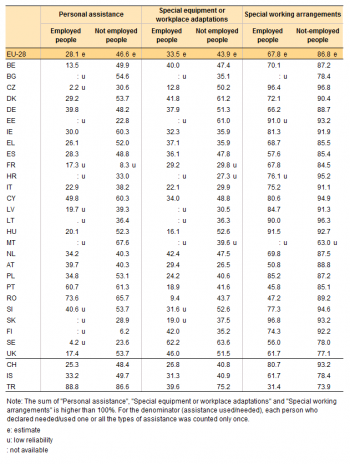Archive:Disability statistics - need for assistance
- Data from Month YYYY. Most recent data: Further Eurostat information, Main tables and Database. Planned article update: (dd) Month YYYY(, hh:00).
This article is part of the set of articles on Disability. It provides information on the special assistance used or needed by persons having a longstanding health problem or an activity difficulty (LHPAD) for enabling them to work, based on the data reported in the framework of the 2011 ad hoc module of the EU Labour Force Survey (AHM). The information covers 31 countries (the EU-28 Member States, Turkey, Iceland and Switzerland).
Main statistical findings
About 28% of the not employed persons having a LHPAD would need a special assistance
Among people employed with a longstanding health problem or an activity difficulty, 8.5% reported that they were provided with some assistance in teh EU-28, ranging from 4% in France to a maximum of 34% in the Netherlands. This latter country (together with Denmark and Iceland) hence appears to provide more assistance in order to facilitate the integration of persons with LHPAD.

In the EU-28, 28% of the persons with a LHPAD that are not employed consider that they would need some form of assistance. The proportion fluctuated between 8% in France (the only country to record a proportion below 10%) and more than 50% in Iceland, Denmark, Romania, Slovakia and Slovenia.

Men would need more often special assistance in order to work
In the EU-28, 9% of the employed women with LHPAD declared using some form of assistance at work, whereas 8% of the employed men with LHPAD used such assistance. The proportion of women using a special assistance was higher than men in all countries, except in Switzerland, Croatia, Greece, Poland and Cyprus. Denmark recorded the highest gap between employed men and women, with 26% for men and 33% for women.
Among not employed people, the share of women who would need special assistance at work (27%) was smaller than that of men (29%) both at EU-28 level and in most countries. The highest differences in the populations were in Cyprus where one men out of two would need special assistance against 37% of the not employed women. On the opposite, Iceland recorded rates of 56% for women and 43% for men who would need special assistance at work.

'Special working arrangements' was the most reported form of special assistance
For each type of assistance, the share of employed people with LHPAD using assistance was significantly lower at EU-28 level than the percentage of those not employed with LHPAD who would need such assistance. For instance, 2.3% of the employed people benefited from personal assistance, while 13% of the not employed reported a need for such help. A special equipment or workplace adaptations concerned 3.3% of the employed and would be needed by 12% of the not employed. A special working arrangement was reported by 5.2% of the employed and would be needed by 24% of the not employed.
As for employed people with a LHPAD, special working arrangements such as sedentary jobs or teleworking are the type of assistance the most often reported in all countries (up to 22% in the Netherlands and 21% in Denmark) except Portugal, Romania and Turkey (where personal assistance is more used) and Sweden (where special equipment adaptations is preferred by 7%). Special equipment is most frequently used in the Netherlands (15%) and Denmark (13%). As for the provision of personal assistance, the highest shares are observed in Romania, the Netherlands and Turkey (all with 11%). The various types of assistance were more used in general by women than by men.
As for non employed people with a LHPAD, special working arrangements were most often quoted in all countries (but Malta and Turkey) with proportions varying from 7% in France and 10% in Hungary up to more than 50% in Slovenia and Slovakia. One quarter or more of the respondents mentioned the need for special equipment in Denmark (32%) and Slovenia (28%), as well as the need for personal assistance in Romania (35%), Slovenia (29%), Denmark (28%), Turkey (27%) and Cyprus (26%). The proportion of men who would need special assistance was always higher than the ratio of women.

Regarding the age distribution, whatever the type of assistance (either needed by the non-employed or actually used by the employed), the proportion of people aged 45-64 was systematically higher than the other age groups. For instance, within the not employed with LHPAD, 34% of the 45-54 years olds would need a special working arrangement. More noteworthy is that, when comparing the types of assistance, an over-representation of persons aged 15-24 (whatever their labour status) was registered for the use of personal assistance (2.5% for the employed population, 8.7% for the non-employed population).
Data sources and availability
All statistics presented in this article are derived from the European Union Labour Force Survey. This is a quarterly, large sample survey providing results for the population living in private households in the EU, EFTA and the candidate countries.
The LFS included an ad-hoc module on employment of disabled people in 2002 and 2011. The aim of the 2011 module was to provide information on the situation of disabled people on the labour market as compared to those without disabilities. The target population for the module was the working age population (i.e. population aged 15-64).
Concepts and definitions
Assistance The article differentiates between the assistance needed - which refers to persons that are not employed (i.e. unemployed and inactive) - and the assistance actually used - which refers to employed persons - by disabled people. "Assistance" encompasses special personal assistance (from family members, relatives, friends, colleagues or other persons), organisational and environmental changes (special equipment/workplace adaptations, and special working arrangement) which help a person carrying out work activities. Such assistance can be regarded as methods to remove barriers to participation in work for disabled persons.
Disability Two main concepts of disability are used in this article:
- Longstanding health problems or diseases: longstanding is to be understood as a health problem that has lasted or is likely to last for at least 6 months. The main characteristic of a longstanding problem is that it is permanent and may be expected to require a long period of supervision, observation or care.
- Basic activity difficulty: an activity is defined as the performance of a task or action by an individual and thus basic activity difficulties are defined as difficulties in performing a basic activity (such as seeing, hearing, lifting, bending, etc) by the respondent. The length of difficulty must have lasted or be expected to last for six months or more.
Context
The UN Convention on the Rights of Persons with Disabilities recognizes in Article 27 “the right of persons with disabilities to work, on an equal basis with others; this includes the right to the opportunity to gain a living by work freely chosen or accepted in a labour market and work environment that is open, inclusive and accessible to persons with disabilities”. This includes prohibition of discrimination, protection of rights, access to education, employment in the public and private sector, possibilities for self-employment and support in order to maintain employment on equal terms with others. The OECD acknowledged as far back as 1992 that: “A need for more co-ordination of all policies which affect the labour market participation of people with disabilities is an overriding concern”. The national reports on the employment of disabled people in European countries provide evidence of widespread initiatives in policy and legislation in recent years. These include, for example, the right to an interview (e.g. in Poland and Denmark), assistance in adaptation of the workplace, employer incentives/subsidies, rights to flexible working, job matching, personal assistance at work, support for self-employment, etc. Although many initiatives have been taken, and more focus has been given to the integration of disabled people, more can be done. There is thus still a need for more knowledge, and more co-ordination in the area. Indeed, there is a relative lack of information about the types of jobs and sectors that disabled people are employed in, not least because many disabled people employed in the ordinary labour market are not recognised or measured in reported figures, e.g. because they are not recorded as having work limitations or receiving specific support services.
See also
Further Eurostat information
Publications
- Statistical analysis and publication of the results of the 2011 Labour Force Survey ad hoc module on employment of disabled people
Database
- Disability, see:
- Access to labour market for disabled people (Source LFS)(hlth_dsb_lm)
Dedicated section
- Health, see
- Disability
Methodology / Metadata
- Prevalence of disability (source LFS) (hlth_dsb_prv)
- Background articles in Statistics Explained
Other information
- Commission Regulation (EU) No 317/2010 of 16 April 2010 adopting the specifications of the 2011 ad hoc module on employment of disabled people for the labour force sample survey provided for by Council Regulation (EC) No 577/98
External links
- European Disability Strategy 2010-2020
- The International Classification of Functioning, Disability and Health (ICF)
- United Nations Convention on the Rights of Persons with Disabilities (UNCRPD)
[[Category:<Health>|Disability statistics - need for assistance or support and offer]] [[Category:<Population>|Disability statistics - need for assistance or support and offer]] [[Category:<Statistical article>|Disability statistics - need for assistance or support and offer]]